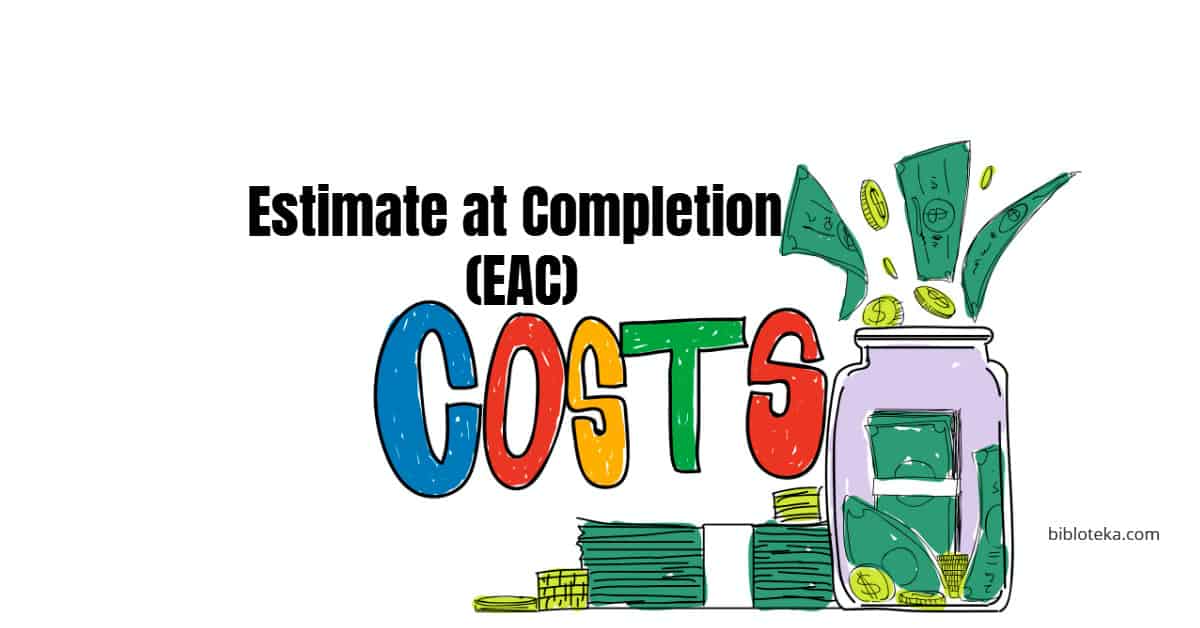Estimate at Completion (EAC) is a project management term that forecasts the project budget while the project will still be in progress. It is a key element of earned value management, similar to BAC (Budget at Completion).
What is Estimate at Completion in Project Management?
Estimate at Completion in Earned Value Management is “The expected total cost of completing all work expressed as the sum of the actual cost to date and the estimate to complete.” according to the PMBOK Guide
Estimate at completion (EAC) is a forecasting method used to estimate the cost of the project at completion. Calculation of the estimate at completion helps to measure how far a project can be off-track and can help inform the most appropriate corrective action to be taken.
There are four ways in which the completion calculation can be measured. Each formula is used for a specific scenario, taking into account different factors.
Estimate at Completion (EAC) Formulas
The most common method of determining the EAC is the “bottom-up” formula where actual costs (AC) are added to the forecasted remaining expenditure – the to be completed estimate (ETC).
1.EAC = BAC / CPI
2.EAC = AC + (BAC – EV)
3.EAC = AC + [(BAC – EV) / (CPI * SPI)]
4.EAC = AC + Bottom-up Estimate to Complete
Formula #01: EAC = BAC / CPI
Example:
Project XYZ is to be completed in 12 months and the cost is 200,000 USD. 6 months have passed, and 120,000 USD has been spent, but upon closer review, you find that only 40% of the work has been completed.
Find the Estimate at Completion (EAC) for this project.
Given:
Budget at Completion (BAC) = 200,000 USD
Actual Cost (AC) = 120,000 USD
Planned Value (PV) = 50% of 200,000
= 100,000 USD
The question did not say that the Planned Value was 50%. However, it says that the duration is 12 months and 6 months have passed. In this case, you can safely assume that the PV was 50% unless it is given in the question.
Earned Value (EV) = 40% of 200,000
= 80,000 USD
First, you have to calculate the Cost Performance Index to calculate the EAC:
Cost Performance Index (CPI) = EV / AC
= 80,000 / 120,000
= 0.67
Cost Performance Index (CPI) = 0.67
Estimate at Completion (EAC) = BAC / CPI
= 200,000 / 0.67
= $298,507.46
Hence, the Estimate at Completion (EAC) is $298,507.46.
In other words, if the project continues with CPI = 0.67 until the end, you will have to spend $298,507.46 to complete it.
The Estimate at Completion (EAC) will give you the amount of money the project will cost at the end.
Formula #02: EAC = AC + (BAC – EV)
Project XYZ with a budget of 1,000,000 USD. A problem happened during the construction works that cost you a lot of money. However, you are sure that this won’t happen again, and that you can continue with your calculated performance for the rest of the project.
To date, you spent 400,000 USD, and the value of the completed work is 350,000 USD.
You need to calculate the Estimate at Completion (EAC).
You have to use formula#02 because the cost increase is temporary and you can complete the rest of the project as planned.
EAC = AC + (BAC – EV)
Given:
Actual Cost (AC) = 400,000 USD
Budget at Completion (BAC) = 1,000,000
Earned Value (EV) = 350,000
EAC = 400,000 + (1,000,000 – 350,000)
= 400,000 + 650,000
= 1,050,000 USD
Hence, the Estimate at Completion is $1,050,000 .
Formula #03: EAC = AC + [(BAC – EV) / (CPI * SPI)]
Example:
Project XYZ has a fixed deadline with a budgeted cost of 1,000,000 USD. To date, you have spent 400,000 USD, and the value of the completed work is 350,000 USD. However, according to the schedule, you should have earned 450,000 USD by now.
Calculate the Estimate at Completion (EAC).
Given:
Budget at Completion (BAC) = 1.000,000 USD
Actual Cost (AC) = 400,000 USD
Earned Value (EV) = 350,000 USD
Planned Value (PV) = 450,000 USD
To calculate the EAC, first you have to calculate the CPI and SPI:
SPI = EV / PV
= 350,000 / 450,000
= 0.73
CPI = EV / AC
= 350,000 / 400,000
= 0.88
Now, you can use the formula:
EAC = AC + [(BAC – EV) / (CPI * SPI)]
= 400,000 + (1,000,000 –450,000) / (0.73* 0.88)
= 400,000 + 550,000 / 0.6424
= 400,000 + 856,164
= 1,256,164 USD
Hence, the Estimate at Completion is 1,256,164 USD.
Formula #04: EAC = AC + Bottom-up Estimate to Complete
Example:
Project XYZ has a budget of 1,000,000 USD to date, you have spent 400,000 USD, and the value of the completed work is 350,000 USD. However, you noticed your cost estimation was flawed. Therefore, you need to calculate the budget again for the remaining works of the project.
You have started re-estimating the cost of the remaining work. The new estimate shows that it would take 800,000 USD to complete the remaining of the project.
Calculate the Estimate at Completion (EAC).
Given:
Budget at Completion (BAC) = 1,000,000 USD
Actual Cost (AC) = 400,000 USD
Earned Value (EV) = 350,000 USD
Bottom-up Estimate to Complete = 800,000 USD
EAC = AC + Bottom-up Estimate to Complete
= 400,000 + 800,000
= 1,200,000 USD
Summary
The Estimate at Completion (EAC) is an effective forecasting tool that enables project management teams to produce realistic estimates of the total cost of completing a project. This tool is important to creating realistic budget revisions.
It should be noted that the EAC is an important concept for the PMP Certification exam. Do you use the EAC for budget planning, as well as schedule variance, cost variance, and budget at completion?
See Also









